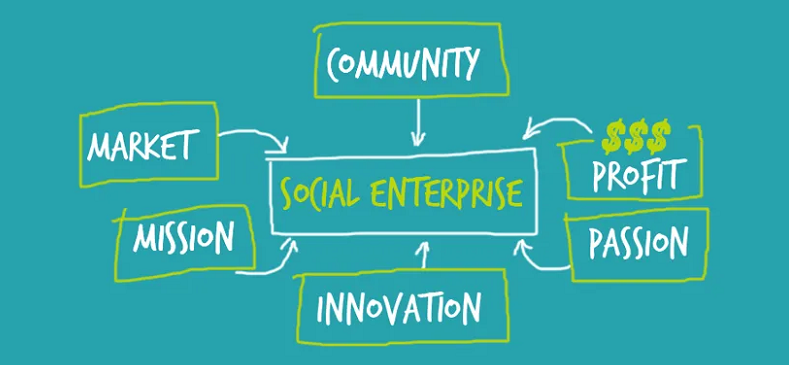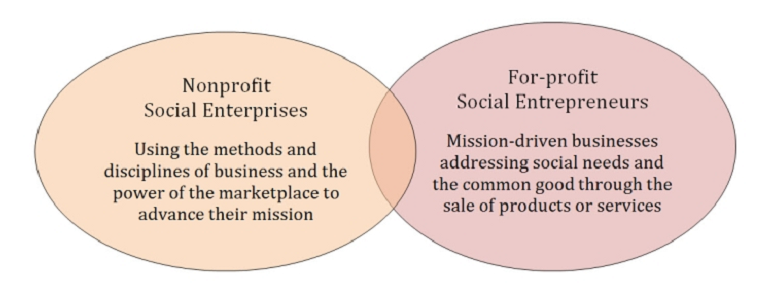
In the business landscape, the Limited Liability Company (LLC) has long been praised for its versatility, offering entrepreneurs flexibility, asset protection, and favorable tax advantages. Parallelly, in the realm of making meaningful change, social enterprises have emerged as a beacon, blurring the lines between for-profit strategies and a deep-rooted commitment to societal betterment. But what happens when we attempt to fuse these two models? Is it feasible for an LLC to serve as the bedrock of a social enterprise? And can such entities harmoniously intertwine the pursuit of profit with a clear-cut social mission?
Contents
- Social Enterprises Defined
- Challenges in Adapting the LLC Model for Social Enterprises
- Opportunities and Advantages for Social Enterprises Using the LLC Model
- Steps to Form and Manage an LLC-based Social Enterprise
- Best Practices for Merging Profit and Purpose in an LLC
- References
Social Enterprises Defined
In the vast universe of businesses, social enterprises occupy a unique constellation, shining bright with a dual mission. These entities are driven not just by the aim to be profitable, but also by the aspiration to effect tangible, positive changes in society.
The Dual Mission
Social Impact
At the heart of every social enterprise is a mission to create social or environmental impact. Whether it’s by providing employment opportunities for marginalized communities, addressing environmental concerns, or enhancing access to education and healthcare, social enterprises seek to address pressing societal challenges. The impact is often measurable, and many social enterprises use metrics and indicators to gauge their success in this realm, ensuring accountability and transparency.
Financial Sustainability
While creating a positive impact is paramount, social enterprises also operate within the practical world of commerce. This means they need to ensure financial sustainability. Unlike non-profits, which primarily rely on donations and grants, social enterprises seek to generate revenue, reinvesting a significant portion of their profits back into their mission. This dual focus ensures their longevity and allows them to scale their impact over time.
Examples of Successful Social Enterprises
Several social enterprises have made waves in the business world, demonstrating that it’s indeed possible to blend profitability with purpose. Companies like TOMS Shoes, with their one-for-one model, have showcased how consumer purchases can directly contribute to charitable causes. Another example is Patagonia, an outdoor clothing company that integrates environmental activism into its business practices, continuously working to reduce its ecological footprint. These enterprises, among many others, have carved out a niche for themselves, demonstrating that with the right strategy, businesses can thrive while making the world a better place [1].

Challenges in Adapting the LLC Model for Social Enterprises
Marrying the ethos of social enterprises with the mechanics of the LLC model might seem like a match made in heaven. The flexibility of the LLC structure dovetails nicely with the evolving needs of socially conscious businesses. However, it’s not without its challenges.
Balancing Profit and Social Impact
The LLC model, in its traditional sense, prioritizes profit maximization for its members or shareholders. When juxtaposed against the mission-driven nature of social enterprises, a tension arises.
Prioritizing Mission Over Profit
For social enterprises, the mission isn’t just a side project; it’s the core of their existence. Ensuring that the LLC operating agreement reflects this can be a challenge. The traditional focus on profit might overshadow the social goals, especially in scenarios of business decisions that could enhance profit but dilute the mission.
Stakeholder Expectations
Stakeholders in an LLC, be it investors or members, often come in with the primary expectation of financial returns. In a social enterprise context, aligning these expectations with mission-driven objectives can be a tightrope walk.
Investor Expectations
Return on Investment (ROI) Concerns
Traditional investors seek quantifiable and often swift returns on their investments. Social enterprises, with their dual focus, might provide slower financial ROI in favor of significant social returns. Communicating this balance to potential investors and managing their expectations is critical [2].
Long-term Commitment
Many social impact initiatives require long-term dedication to truly make a change. This can be at odds with investors who are looking for quicker exits or short-term gains from their investments.
Regulatory and Compliance Issues
The legal landscape surrounding businesses is complex and becomes even more so when venturing into the terrain of social impact.
Ambiguity in Legislation
While some jurisdictions recognize hybrid business models like the Benefit Corporation, many still lack clear legal frameworks for LLCs with a social mission. This can lead to challenges in compliance and potential legal vulnerabilities.
Reporting Requirements
Demonstrating social impact might require unique reporting mechanisms and metrics, going beyond the standard financial reports of traditional LLCs. Ensuring compliance with both financial and impact reporting can be resource-intensive.

Opportunities and Advantages for Social Enterprises Using the LLC Model
While there are undeniably challenges in fusing the traditional LLC structure with the ethos of social enterprises, the convergence also brings forth a slew of exciting opportunities. The inherent flexibility and adaptability of the LLC model offer social enterprises a myriad of benefits, many of which can help them amplify their social impact while ensuring financial sustainability.
Adaptability and Flexibility of LLCs
The very nature of an LLC is rooted in its ability to be malleable to the needs of its members. This adaptability is a boon for social enterprises, as it can be tailored to their unique requirements.
Customizable Operating Agreements
One of the hallmarks of the LLC model is the ability for members to craft an operating agreement suited to their needs. For social enterprises, this means explicitly embedding their mission and social objectives, ensuring that both profit and purpose are integral to the business’s operations.
Diverse Membership Structures
Unlike rigid corporate structures, an LLC offers the flexibility to have a diverse set of members. Social enterprises can leverage this to include members from impacted communities or those with aligned social missions, thereby deepening their social engagement [3].
Aligning Mission and Profit Incentives
The LLC model, with its inherent profit-driven mechanism, can be a catalyst in ensuring that the social mission of an enterprise does not remain a mere sideline activity.
Sustainable Funding Streams
By operating as an LLC, social enterprises can generate consistent revenue streams. This financial stability can be reinvested to further their social objectives, creating a virtuous cycle of profit and impact.
Attracting Impact Investors
There’s a growing cohort of investors specifically interested in ventures that offer both financial returns and social impact. Operating as an LLC can make social enterprises more appealing to such impact investors, providing them with both equity and mission-driven investment opportunities.
Potential for Unique Tax Benefits
While LLCs are generally known for their pass-through taxation benefits, there are nuanced tax considerations that can further benefit social enterprises.
Pass-Through Taxation
LLC members report their share of profit or loss on their individual tax returns, potentially avoiding double taxation. For social enterprises, this means more funds can be redirected towards their social initiatives.
Charitable Initiatives and Deductions
If an LLC social enterprise undertakes charitable activities, it might be eligible for certain tax deductions, further bolstering its financial health and ability to drive its mission [4].

Steps to Form and Manage an LLC-based Social Enterprise
Embracing the LLC model for a social enterprise is not just about understanding its theoretical benefits. It requires a hands-on, step-by-step approach to ensure the formation and management align seamlessly with both profit-driven and mission-based objectives.
Selecting a Jurisdiction with Favorable Laws
The legal landscape for social enterprises varies widely across jurisdictions. It’s essential to choose a location that supports and understands the dual nature of your endeavor.
Researching State Regulations
Before settling on a location for your LLC, research the laws in various states. Some states may have favorable legislation or specific statutes catering to hybrid business models, which can be advantageous for your social enterprise.
Considering Local Benefits
Some jurisdictions might offer tax incentives, grants, or support programs for social enterprises. Weigh these benefits when deciding on the best location for your LLC.
Drafting an Operating Agreement
An operating agreement serves as the backbone of an LLC, detailing its operational and financial decisions. For a social enterprise, this document is crucial to ensure the alignment of business and mission goals.
Incorporating Social Mission Objectives
Clearly articulate your social mission within the operating agreement. Define metrics of success, both in terms of financial returns and societal impact, ensuring all members are on board with the dual objectives.
Structuring Profit Distribution and Reinvestment
As a social enterprise, decide how profits will be distributed. Establish clauses detailing the percentage of profits to be reinvested into the social mission. This ensures sustainability and continued growth in the impact sector.
Ongoing Management Considerations
Forming the LLC is just the beginning. Effective management is key to ensuring the enterprise thrives and successfully merges its profit and purpose.
Monitoring Social Impact Metrics
Regularly track and assess the impact your enterprise is making. Employ tools and frameworks like the Social Return on Investment (SROI) or the Impact Reporting and Investment Standards (IRIS) to quantify your results.
Transparency and Reporting
Foster a culture of transparency. Regularly communicate your financial health and social impact to stakeholders, members, and the public. This not only builds trust but also strengthens your brand as a genuine social enterprise.
Best Practices for Merging Profit and Purpose in an LLC
Walking the tightrope between profit generation and social impact within an LLC structure might seem daunting. However, with a careful and strategic approach, it’s not just possible, but can be deeply rewarding. By adopting best practices that honor both objectives, LLC-based social enterprises can flourish, setting a gold standard for other businesses to follow.
Aligning Stakeholder Interests
Before embarking on any business decision, it’s essential to ensure that all stakeholders are on the same page, understanding and valuing the dual objectives of the enterprise [5].
Open Communication Channels
Foster an environment where members, investors, and other stakeholders can voice concerns, provide feedback, and collaboratively brainstorm solutions. Regular meetings, forums, or town halls can serve as platforms for this dialogue.
Educate and Engage
Actively educate your stakeholders about the importance of your social mission. Workshops, seminars, and impact tours can provide a firsthand view of the change your enterprise is driving, ensuring deeper alignment and commitment.
Strategic Financial Planning
Striking a balance between profit and purpose requires meticulous financial planning, ensuring that both objectives are adequately funded.
Dedicated Funds for Social Initiatives
Allocate a specific portion of the enterprise’s profits for social impact projects. This ensures a steady flow of resources to drive the mission forward, irrespective of external economic fluctuations.
Diversified Revenue Streams
Look for multiple avenues to generate income. From product sales to services, workshops, or licensing deals, diversifying ensures financial resilience while providing flexibility to support the social mission.
Continuous Impact Assessment
Profit metrics are often clear and tangible. The same precision should be applied to measuring social impact.
Adopt Standardized Metrics
Utilize recognized impact measurement tools and standards, such as the previously mentioned SROI or IRIS. This offers credibility to your assessments and allows for meaningful comparisons over time.
Regular Reviews and Adjustments
Social impact isn’t static. As the landscape changes, so should your strategies. Conduct periodic reviews of your impact metrics, adjusting goals and tactics as necessary to maximize positive change.
Maintaining Transparency
Trust is the bedrock of any successful venture, especially when juggling the dual objectives of profit and purpose.
Publish Regular Reports
Make it a practice to release annual or biannual reports detailing both your financial health and your social impact. This not only keeps stakeholders informed but also strengthens your brand’s reputation in the market.
Engage in Third-Party Audits
External audits, especially for social impact, lend credibility to your enterprise. They offer an unbiased view of your operations, ensuring accountability and fostering trust among investors and the public.
References
[1] The Social Enterprise Life Cycle
[2] Challenges Facing Social Enterprises in the United States
[3] Profit with Purpose? A Theory of Social Enterprise
[4] The Organization of Social Enterprises
[5] Social Enterprise Law: A Theoretical And Comparative
Perspective
